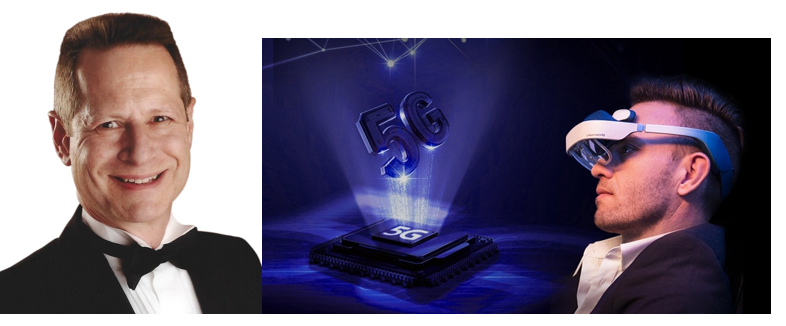Emerging Augmented Reality (AR) technologies are driving increased demand for innovations, 5G will provide the key to unlocking AR’s potential

Today, adults in the U.S. spend over nine hours a day looking at screens. That counts for more than a third of our livelihoods.
Yet even though they serve as a portal to 90 percent of our media consumption, screens continue to define and constrain how and where we consume content, and they may very soon become obsolete.
Riding new advancements in hardware and connectivity, augmented reality (AR) is set to replace these 2D interfaces, instead allowing us to see through a digital information layer. And ultimately, AR headsets will immerse us in dynamic stories, learn-everywhere education, and even gamified work tasks.
If you want to play AR Star Wars, you’re battling the Empire on your way to work, in your cubicle, cafeteria, bathroom and beyond.
We got our first taste of AR’s real-world gamification in 2016, when Nintendo released Pokemon Go. Thus began the greatest cartoon character turkey shoot in history. With 5 million daily users, 65 million monthly users, and over $2 billion in revenue, the virtual-overlaid experience remains one for the books.
In the years since, similar AR apps have exploded. Once thick and bulky, AR glasses are becoming increasingly lightweight, stylish, and unobtrusive. And over the next 15 years, AR portals will become almost unnoticeable, as hardware rapidly dematerializes.
Companies like Mojo Vision are even rumored to be developing AR contact lenses, slated to offer us heads-up display capabilities — no glasses required.
In this second installation of our five-part AR blog series, we are doing a deep dive into the various apps, headsets, and lenses on the market today, along with projected growth.
Let’s take a look…
Mobile AR
We have already begun to sample AR’s extraordinary functions through mobile (smartphone) apps. And the growth of the market is only accelerating.
Snap recently announced it will raise $1 billion in short-term debt to invest in media content, acquisitions, and AR features. Both Apple and Google are racing to deploy phones with requisite infrastructure to support hyper-realistic AR.
And in the iOS space, developers use ARKit in iPhone software, from the SE to the latest-generation X, to bring high-definition AR experiences to life. Apple CEO Tim Cook has repeatedly emphasized his belief that AR will “change the way we use technology forever.”
While recent rumors reveal the company’s AR glasses project has been discontinued, Apple’s foray in AR is far from over. Just recently, the tech giant broadcasted a large collection of job postings for AR and VR experts. And although somewhat speculative, Apple is likely waiting for the consumer market to mature before releasing its first-generation AR glasses or pivoting towards an entirely new AR hardware product.
For now, Apple seems to be promoting the extensive hardware advancements showcased by its A12 bionic chip, not to mention the variety of apps available in its App Store.
- In the productivity realm: IKEA place allows users to try out furniture in the home, experimenting with styles and sizing before ordering online. Or take Vuforia Chalk, a novel AR tool that helps customers fix appliances with real-time virtual assistance. As users direct their smartphone cameras towards troublesome appliances, remote tech support workers can draw on consumers’ screens to guide them through repair steps.
- As to the AR playground, Monster Park brings Jurassic Park dinosaurs into any landscape you desire, immersing you in a modern-day Mesozoic Era. Meanwhile, Dance Reality can guide you through detailed steps and timing of countless dance styles.
- In virtually immersive learning, BBC’s Civilisations lets you hold, spin, and view x-rays of ancient artifacts while listening to historical narrations. WWF’s Free Rivers transforms your tabletop into natural landscapes, from the Himalayas to the African Sahara, allowing you to digitally manipulate entire ecosystems to better understand how water flow affects habitats.
- Or even create your own DIY AR worlds and objects using Thyng.
Yet for Android users, options are just as varied, based on the Android software-compatible ARCore used by developers. While the recently announced Google Glass Enterprise Edition 2 aims to capture enterprise clients, Android smartphone hardware provides remarkable AR experiences for everyday consumers.
- For sheer doodling, DoodleLens (Android APP) brings your doodles to life, transforming paper drawings into 3D animated figures that you can place and manipulate in your physical environment. And even more directly, Just a Line (Android APP) allows anyone to create a 3D drawing within their physical surroundings, making space itself an endless canvas.
- Learn as you travel: Google Translate (Android APP) can now take an image of any foreign street sign, menu, or label and provide instantaneous translation in real time. And beyond Earth-bound adventures, the now open-sourced Sky Map (Android APP) guides you through constellations across the night sky.
- Even alter your own body with Inkhunter, (Android APP) which allows users to preview any potential tattoo design on their skin. Or as is familiar to most younger folks, change your look with Snapchat’s (Android APP) computer vision-derived filters, which have already reached 90 percent of 12-to 24-year-olds in the U.S.
Leading Headsets
Although the number of AR headsets breaking into the market may seem overwhelming, a few of the top contenders are now pushing the envelope in everything from wide FOV immersion to applications in enterprise.
(1) Highest Resolution
DreamGlass: Connected to a PC or Android-based smartphone, DreamWorld’s headset offers 2.5K resolution in each lens, beating out Full HD resolution screens, but in AR. Now flooded by investment, resolution improvements minimize pixel size, reducing the “screen door effect,” whereby pixel boundaries disrupt the image like a screen’s mesh. Offering unprecedented levels of hand- and head-tracking precision, the headset even features 6 degrees of freedom (i.e. axes of directional rotation).
And with a flexible software development kit (SDK), supported by Unity and Android, the device is highly accessible to developers, making it a ready candidate for countless immersive experiences. Already at $619, the DreamGlass and comparable technology are only falling in price.
(2) Best for Enterprise
Google Glass Enterprise Edition 2: In just four years (since Google’s release of the last iteration), the Google Glass has gotten a major upgrade, now geared with an 8-megapixel camera, detachable lens, vastly increased battery life, faster connection, and ultra-high-performance Snapdragon XR1 CPU. Already, the Glass has been sold to over 100 businesses, including GE, agricultural machinery manufacturer AGCO, and health record company Dignity Health.
But perhaps most remarkable are the bucks AR can make for business. Using the Glass, GE has increased productivity by 25 percent, and DHL improved its supply chain efficiency by 15 percent. While only (currently) available for businesses, the new-and-improved AR glasses stand at $999 and will continue to ride plummeting production costs.
(3) Democratized AR
Vuzix Blade: Resembling chunky Oakley sunglasses, these smart glasses are extraordinarily portable, with a built-in Android OS as well as both WiFi and Bluetooth connection. Designed for everyday consumer use (at a price point of $700), the Vuzix Blade is slowly chipping away at smartphone functionalities. For easy control of an intuitive interface, a touchpad on the device’s temples allows consumers to display everything from social media platforms and user messages to “light AR” experiences. Meanwhile, an 8MP HD camera makes your phone camera null and void, allowing users to remain immersed in their experience while digitally capturing it at the same time. All the while, built-in Alexa capabilities and vibration alerts extend users’ experience beyond pure visual stimulation.
(4) Widest Field of View (FOV)
Microsoft HoloLens 2: This newly announced headset leads the industry with a 43° x 29° FOV, more than double its (2016-released) predecessor’s capability. But this drastic increase in visual immersiveness is far from the only device improvement. For improved long-use comfort, the headset’s center of gravity now rests on the top of the head, moving away from typical front-loaded headsets.
An even more novel functionality, tiny cameras on the nose bridge verify a user’s identity by scanning the wearer’s eyes and customizing the display based on distance between pupils. Once accompanied by emotion-deducing AIs (now under development), this tracking technology could even evolve to intuitively predict a user’s desires and emotional feedback in future models. Geared with a Qualcomm 850 mobile processor and Microsoft’s own AI engine built-in, Hololens’ potential is limitless.
(5) Class A Comfort
Magic Leap One: Weighing less than 0.8 pounds, this headset provides one of the most lightweight experiences available today with a 40° x 30° FOV, just barely eclipsed by that of Microsoft’s HoloLens 2. En route to dematerialization, Magic Leap merely requires a small “Lightpack” attachment in the wearer’s pocket, connected via cable to the goggles. A handheld controller additionally contains a touchpad, haptic feedback, and six degrees of freedom motion sensing. Meanwhile, light sensors make the digital renderings even more realistic, as they reflect physical light into the viewer’s space.
Teasing AR’s future convergence with AI, Magic Leap even features a virtual human called “Mica,” which responds to a user’s emotions (detected through eye-tracking) by returning a smile or offering a friendly gesture.
Final Thoughts
As headsets plummet in price and size, AR will rapidly permeate households over the next decade.
Once we have mastered headsets and smart glasses, AR-enabled contact lenses will make our virtually enhanced world second nature.
And ultimately, BCIs will directly interface with our neural signals to provide an instantaneous, seamlessly intuitive connection, merging our minds with limitless troves of knowledge, rich human connection, and never-before-possible experiences.
While only approaching the knee of the curve, these pioneering mobile apps and novel headset technologies explored above will soon give rise to one of the most revolutionary industries yet to be seen— one that will fundamentally transform our lives.
Just remember over 120 million workers throughout the world (11.5 million in the U.S.) will need to be retrained in the next three years due to artificial intelligence, according to an IBM survey. “Upskilling” these workers will be a big challenge as workers today require more training than ever to learn new skills — 36 days versus three days in 2014, per IBM. And often skills most valued by employers (“soft skills” like communication and ethics) take more time to develop.

Board of Directors | Board of Advisors | Strategic Leadership
Please keep me in mind as your Executive Coach, openings for Senior Executive Engagements, and Board of Director openings. If you hear of anything within your network that you think might be a positive fit, I’d so appreciate if you could send a heads up my way. Email me: [email protected] or Schedule a call: Cliff Locks

#BoardofDirectors #BoD #artificialintelligence #AI #innovation virtualreality #vr #d #augmentedreality #HR #executive #business #CXO #CEO #CFO #CIO #executive #success #work #follow #leadership #corporate #office #Biotech Cleantech #entrepreneur #coaching #businessman #professional #excellence #development #motivation Contributors: Peter Diamandis and Clifford Locks #InvestmentCapitalGrowth
